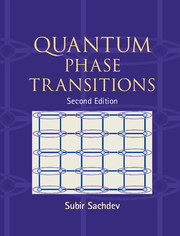Book contents
- Frontmatter
- Contents
- From the Preface to the first edition
- Preface to the second edition
- Part I Introduction
- Part II A first course
- Part III Nonzero temperatures
- 10 The Ising chain in a transverse field
- 11 Quantum rotor models: large-N limit
- 12 The d = 1, O(N ≥ 3) rotor models
- 13 The d = 2, 0(N ≥ 3) rotor models
- 14 Physics close to and above the upper-critical dimension
- 15 Transport in d = 2
- Part IV Other models
- References
- Index
12 - The d = 1, O(N ≥ 3) rotor models
from Part III - Nonzero temperatures
Published online by Cambridge University Press: 16 May 2011
- Frontmatter
- Contents
- From the Preface to the first edition
- Preface to the second edition
- Part I Introduction
- Part II A first course
- Part III Nonzero temperatures
- 10 The Ising chain in a transverse field
- 11 Quantum rotor models: large-N limit
- 12 The d = 1, O(N ≥ 3) rotor models
- 13 The d = 2, 0(N ≥ 3) rotor models
- 14 Physics close to and above the upper-critical dimension
- 15 Transport in d = 2
- Part IV Other models
- References
- Index
Summary
This and the following chapter are at a more advanced level, and some readers may wish to skip ahead to Chapter 14.
In Chapter 11 we studied the O(N) quantum rotor model in the large-N limit for a number of values of the spatial dimensionality, including d = 1. We noted that the results provided an adequate description of the static properties when d = 1 for N ≥ 3. This is justified in the present chapter where we obtain a number of exact results for the same static observables. We also noted that the large-N limit did a very poor job of describing dynamical properties at nonzero temperatures. This is repaired in this chapter by simple physical arguments that lead to a fairly complete (and believed exact) description of the long-time behavior. Some of the discussion in this chapter is specialized to the O(N = 3) model, which is also the case of greatest physical importance; the properties of the O(N > 3) models are very similar, and many of our results are quoted for general N. Of the remaining cases, the d = 1, N = 1 model has already been considered in Chapter 10, and study of the d = 1, N = 2 model is postponed to Section 20.3.
- Type
- Chapter
- Information
- Quantum Phase Transitions , pp. 190 - 212Publisher: Cambridge University PressPrint publication year: 2011



